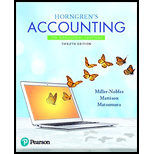
Accounting principles for inventory and applying the lower-of-cost-or-market rule
Learning Objective 1, 4
Some of M and C Electronics’s merchandise is gathering dust. It is now December 31, 2018, and the current replacement cost of the ending merchandise inventory is 524,000 below the business’s cost of the goods, which was $97,000. Before any adjustments at the end of the period, the company’s Cost of Goods Sold account has a balance of $380,000.
Requirements
1. Journalize any required entries.
2. At what amount should the company report merchandise inventory on the
3. At what amount should the company report cost of goods sold on the income statement?
4. Which accounting principle or concept is most relevant to this situation?
Want to see the full answer?
Check out a sample textbook solution
Chapter 6 Solutions
Horngren's Accounting (12th Edition)
- Problem No. 2 The trial balance of Cleint Lumanao Nacho Supplies on February 10, 2025, before accepting Shila Tajonera as partner is shown as follows: Account Title Debit Credit Ato Cash reening smuo P 100,000 Accounts Receivable 250,000 Allowance for Uncollectible Accounts P 20,000 o Merchandise Inventory Equipment Accumulated Depreciation Accounts Payable Notes Payable 120,000 275,000 55,000 50,000 82,000 538,000 Lumanao, Capital Total P 745,000 P 745,000 Tajonera offered to invest cash to get a capital credit equal to one-half of Lumanao's capital after giving effect to the adjustments below. Lumanao accepted the offer. Valuation of some of the assets and liabilities of Lumanao, as agreed by the partners, are the following: • The merchandise is to be valued at P93,000. The accounts receivable is estimated to be 90% collectible. • The equipment is to be valued at P200,000. The partners also agreed that the name of the partnership will be Nacho Business. Required: 1. In the books of…arrow_forwardIf data is unclear in image or image blurr then comment.arrow_forwardSolve correctly without using aiarrow_forward
- Give solution correctly no chatgptarrow_forwardProblem No. 1 On January 1, 2025, Manuel Cruz and Sherimae Diasalo agreed to form a partnership that will manufacture and sell biscuits. The partnership agreement specified that Cruz is to invest cash of P1,000,000 and Diasalo is to contribute land and building to serve as the office and factory of the business. The following amounts are applicable to the property of Diasalo: Acquisition Cost Fair Market Value Land Building P1,000,000 500,000 P1,500,000 850,000 During the formation, it was found out that Cruz has accounts receivable amounting to P70,000 and the partners agreed that it will be assumed by the partnership. The name of the partnership will be Fita Pan. Required: 1. Prepare journal entry to record: a. The investment of Cruz to the partnership b. The investment of Diasalo to the partnershipood relay ni 000,219 2. Prepare the statement of financial position of the partnership as of January 1, 2025 Problem No. 2 The trial balance of Cleint Lumanao Nacho Supplies on February…arrow_forwardA company's stock price is $80, with earnings per share (EPS) of $10 and an expected growth rate of 12%.arrow_forward
- Kazama owns JKL Corporation stock with a basis of $20,000. He exchanges this for $24,000 of STU stock and $8,000 of STU securities as part of a tax-free reorganization. What is Kazama's basis in the STU stock?arrow_forwardKensington Textiles, Inc. manufactures customized tablecloths. An experienced worker can sew and embroider 10 tablecloths per hour. Due to the repetitive nature of the work, employees take a 10-minute break after every 10 tablecloths. Additionally, before starting each batch of 10 tablecloths, workers spend 8 minutes cleaning and setting up their sewing machines. Calculate the standard quantity of direct labor for one tablecloth.arrow_forwardSolvearrow_forward
- Problem: The bank statement balance of $7,000 does not include a check outstanding of $1,000, a deposit in transit of $275, and another company's $250 check erroneously charged against your firm's account. The reconciled bank balance is__?arrow_forwardGiven step by step explanation general accounting questionarrow_forwardQuick answer of this accounting questionsarrow_forward
 Cornerstones of Financial AccountingAccountingISBN:9781337690881Author:Jay Rich, Jeff JonesPublisher:Cengage LearningCentury 21 Accounting Multicolumn JournalAccountingISBN:9781337679503Author:GilbertsonPublisher:Cengage
Cornerstones of Financial AccountingAccountingISBN:9781337690881Author:Jay Rich, Jeff JonesPublisher:Cengage LearningCentury 21 Accounting Multicolumn JournalAccountingISBN:9781337679503Author:GilbertsonPublisher:Cengage Intermediate Accounting: Reporting And AnalysisAccountingISBN:9781337788281Author:James M. Wahlen, Jefferson P. Jones, Donald PagachPublisher:Cengage Learning
Intermediate Accounting: Reporting And AnalysisAccountingISBN:9781337788281Author:James M. Wahlen, Jefferson P. Jones, Donald PagachPublisher:Cengage Learning



